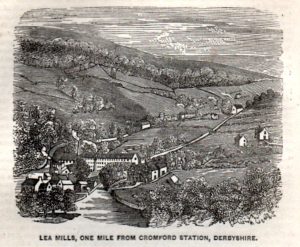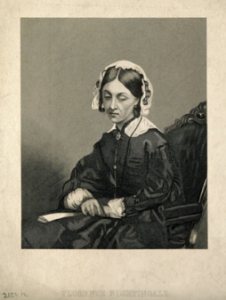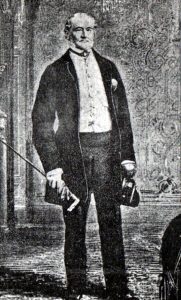
May 7, 2020, by Richard Bates
Parallel Paths in History: Florence Nightingale and John Smedley Jr
This guest piece is written by Steven Schmidt, a volunteer history researcher with the John Smedley Archive Charitable Trust.
[Image: John Smedley’s Hydropathic Institute, Matlock Bank, Derbyshire, c. 1872. Wellcome Collection.]
The central Derbyshire parish of Dethick, Lea, and Holloway is located on the eastern side of the Derwent Valley. Relatively thinly populated today, it has historically been a site of both beauty and industry. Two of the most important families to have lived in this parish during the 1800s were the Nightingales and the Smedleys. Within these families, Florence Nightingale (1820-1910) and John Smedley Jr. (1803-1874) were certainly the most prominent.
The Nightingales and Smedleys knew each other primarily through a long and formal business relationship. Lea Bridge Mill, still in operation today under the Smedley name, was leased to the Smedleys by the Nightingales in 1818 and finally bought by them in 1894. John Smedley’s grandfather Thomas may have been involved with Peter Nightingale as early as 1783-84 when the original textile mill was established at Lea Bridge. John Smedley’s life is less well documented than either Nightingale’s or that of the industrial pioneer Richard Arkwright of Cromford (1732-1792), who also lived in the same valley. Yet Smedley is interesting not just as the creator of the two-hundred-year-old textile manufacturing legacy of Smedley’s Mill, but also for developing a thriving hydropathy hotel business on Matlock Bank in the 1850s, which became nationally recognised for ushering in a ‘new era’ of what was known as ‘The Mild Water Cure’. ‘Smedley’s’ Hydro’ remained a viable business until 1954.

Lea Mill, Lea Bridge, Derbyshire. Unknown Date. Line Drawing. From: John Smedley Jr., Practical Hydropathy, 10th Edition, (London, James Blackwood & Co., 1868).
This article outlines various ways in which Nightingale and Smedley can be compared and contrasted, before going on to examine their views on medicine, and especially hydropathy, in more detail.
Class origins – According to historian Stanley Chapman, Nightingale and her family were actually nouveax riches rather than ‘old landed gentry’. The eighteenth century Nightingales, like other ‘trading gentry’ in Derbyshire, had amassed their wealth from the lead industry. In 1771 Peter Nightingale II (1737-1803), Florence Nightingale’s great-great-uncle, added 1381 acres to his estate, making him one of the leading landowners in the county. His fortune ultimately passed to Florence’s father, William Edward Nightingale (born W. E. Shore), who was highly educated, in receipt of a large estate, and assured a place in the upper echelons of Georgian and Victorian society. This new landed gentry- family now fully distanced itself from the ‘trade’ status of previous generations.
Smedley’s family was part of an aspiring middle-class: modestly successful textile manufacturers struggling in a very competitive industry. Smedley archivist Jane Middleton-Smith argues that even though the Smedleys acquired significant wealth from 1840 onwards, they were likely viewed with a degree of ‘contempt’ by the upper classes who considered them ‘trade’. The century would end however with the Nightingales selling their assets to John Smedley’s heirs who were now wealthy, well-educated industrialists.

Florence Nightingale, 1856. Stipple Engraving by D. J. Pound, 1856. Wellcome Collection.
Education – Both received a formal education, albeit in quite different ways. Smedley was educated at a grammar school in Wirksworth, while Nightingale’s education after 1831 was carried out at home, and with a classical bent, led by her father. Both received formal training for their respective professions: Smedley as an apprentice to his father at Lea Bridge Mill from 1819 to 1826, and Nightingale as a nurse at Kaiserswerth, Germany in 1850-51 and again in Paris in 1853.
Communication – The two figures were avid communicators, but used different methods to get their respective messages across. Smedley was a fiery public speaker first and a writer second. Nightingale relied primarily on the written word – evidenced by the number of books, reports and pamphlets she wrote in her lifetime, as well as many thousands of letters.
Religion: Both Nightingale and Smedley held very strong religious beliefs which thoroughly permeated their personal- and work-lives. While Nightingale maintained a life-long affiliation with the Church of England, her open-mindedness allowed her to explore other religious views and practices – including Roman Catholicism, Lutheranism and Methodism. Smedley was a nonconformist Evangelical whose approach to religion was direct, public and extremely impassioned. His brand of Evangelical activism led him to establish more than eight different chapels and ten church schools around central Derbyshire. His personal spending on these ventures totalled around £20,000 (about £2 million today).
Nightingale and Smedley both wrote books for religious audiences. Nightingale contributed to Benjamin Jowett’s School and Children’s Bible (1872). In 1854, Smedley published A Historical Sketch of the Ancient and Modern Church of Britain, which was more of a modern-day criticism of the Church than a history.

John Smedley Jr., Unknown Date. From: Joseph Buckley, Recollections of the Late John Smedley, 1888.
Philanthropy: Both parties engaged heavily in benevolent endeavours, shaped by their class background and religious priorities. In the late 1830s and early 1840s, Nightingale focused her efforts on the local village poor in the areas surrounding Holloway near Lea Hurst, Derbyshire and Wellow, Hampshire near Embley Park. In part, this was conditioned by an expectation that women in the upper echelon of Victorian society would engage in charity work known as ‘poor peopling’. However for Florence, the need to offer assistance to those in need became analogous to conducting the work of God in the world. Later on, she also worked for the Ragged School movement – and after the Crimean War gave regularly and generously to a variety of causes.
Smedley’s expressions of philanthropic interest began after he returned his family’s mill to profit in 1828, and focused on his mill employees. He set up a food store, supplied clothing for those in need, and paid his staff to attend (compulsory) morning prayers. He gained a reputation as a ‘fair and just’ philanthropic employer who never neglected the poor, the destitute or the ailing – though of course maintaining a warm, dry, well-nourished and punctual workforce was also in his own business interests.
Medicine and Hydropathy
Nightingale and Smedley had quite different views of contemporary medical practices. Nightingale generally accepted the tenets of conventional medicine. Her priority was to carve out a separate space for the new profession of nursing, to run parallel to modern medical practice but be dominated by women and operating independently, with its own structures and agenda. By contrast, following a bout with what was thought to be typhus in 1847, Smedley completely lost his faith in conventional medicine and opted for alternative treatments. His choice was hydropathy, as he sincerely believed that water alone was the cure for all ills.
Smedley took the ‘water cure’ only twice – in 1848 and 1849 at the Ben Rhydding Institute in Ilkely, Yorkshire. Smedley reported that he had barely survived the cold water cure treatments, but was impressed by the religious agenda employed in his treatment schedule. Indeed, he experienced an epiphany at Ben Rhydding, which led directly to the creation of his successful hydropathy treatment centre on Matlock Bank, Derbyshire in 1852-53. There were no trained medical doctors, or even formally trained hydropathists ever to be seen at Smedley’s Hydro until after his retirement in 1872. Smedley himself became the self-appointed ‘water doctor’, employing his innovative ‘mild water cure’.
Nightingale and her family were avid users of hydropathy, but under strict medical supervision. Nightingale made approximately eleven visits to spas and hydropathy institutes for treatment between 1838 and 1858, generally with family and friends who were avid supporters of the treatments. After 1859, Nightingale made three more lengthy visits to the institutes in Malvern. She sought rest, recuperation, solace and a chance to remove herself from the frenetic nature of her work. Nightingale regarded hydropathy as a holistic treatment package consisting of conventional medical interventions, water treatments, fresh air, exercise, good ventilation, diet and quiet rest. She expressed scepticism as to the health benefits of the water itself, but noted that she herself and others had recovered their health in such settings.
Nightingale was not, however, impressed with Smedley’s treatment methods. In a letter to her mother written in 1862, she wrote that it was a good thing that a local man suffering from kidney disease ‘did not try Mr. Smedley whose first bath would certainly have killed him, as it does in all kidney disease’ (1). Nightingale referred to Smedley as a ‘quack’, and in another letter, from 1879, wrote that the ‘miserable Water cure, of Smedley’s … ‘has killed or rendered … infirm for life many more than it cured’ (2). However, historian Jane Adams reports positive results received by those taking treatment from Smedley at Matlock Bank, attesting to the ‘focus on healing’ and the ‘individual care packages’ developed there.
Pathways Convergent
Nightingale and Smedley did however converge in both writing books on health for the ‘home market’ – a popular enterprise in Victorian times. Smedley’s contribution was Practical Hydropathy: including plans of baths and remarks on diet, clothing and habits of life. Complete with equipment designs, anatomical drawings and over 200 ‘home treatments’, it became more of a marketing tool for his Matlock Bank institute than a home remedy kit. Practical Hydropathy was first published in 1857 and ran through 17 editions, the last issued posthumously in 1877. Nightingale’s Notes on Nursing (1860), often assumed to be a manual for the nursing profession, was in fact written for the benefit of ordinary people caring for the sick at home. The book advised people on many facets of home life including fireplace maintenance and appropriate wall coverings. Both Nightingale and Smedley were champions of the principles of sanitation for good health, outlined these in their books and put them into practice within the institutions they created.
More generally, John Smedley and Florence Nightingale – both products of the tumultuous change rippling through Victorian society during their lifetimes – were self-reliant and self-disciplined people who shared many attributes. Both were focused and headstrong in their professional interests, benevolent in their dealings with those less fortunate, and committed to their personal beliefs. Whilst we recognise their differences and the reasons for them, it is far more interesting to examine their commonalities and the parallel pathways they were travelling.
The author would like to thank Richard Bates for his kind attentions, suggestions and editing of this article. Thanks also to Jane Middleton-Smith, Smedley Charitable Trust, for her support and collaboration.
References:
(1) Nightingale to Edwin Chadwick, 16 September 1860, in Lynn McDonald (ed.) Florence Nightingale: An Introduction to Her Life and Family, Volume 1 of the Collected Works of Florence Nightingale, (Waterloo, ON: Wilfrid Laurier University Press, 2001), p. 156.
(2) Nightingale, draft letter to Henry Bonham-Carter, 1879, British Library Add Mss 47720, f75.
Further Reading:
Adams, Jane M., Healing with Water: English Spas and the Water Cure, 1840-1960, (Manchester, Manchester University Press, 2015).
Bostridge, Mark, Florence Nightingale: The Woman and Her Legend, (London, Penguin, 2009).
Buckley Joseph, Matlock Bank (Derbyshire) As It Was and Is, (London, Job Caudwell, 1866).
Buckley, Joseph, Recollections of the Late John Smedley, (London, John Heywood, 1888).
Chapman, Stanley, Peter Nightingale, Richard Arkwright and the Derwent Valley Cotton Mills 1771-1818, Derbyshire Archaeological Journal, Vol. 133, (2013), pp. 166-188.
Middleton-Smith, Jane, Florence Nightingale x John Smedley 1820 – 2020, (Lea Bridge, John Smedley Archive Charitable Trust, 2020). Unpublished Manuscript.
Oakes, J. Margaret, A Window on John Smedley’s World, (Bakewell, Country Books, 1993).
Steer, Henry, The Smedleys of Matlock Bank, (London, Elliot Stock, 1897).
Smedley, John. Practical Hydropathy, 10th Edition, (London, James Blackwood & Co., 1868).
Weaver, Cora, Florence Nightingale and the Water Cure, (Malvern, Cora Weaver Publications, 2010).
No comments yet, fill out a comment to be the first

Leave a Reply